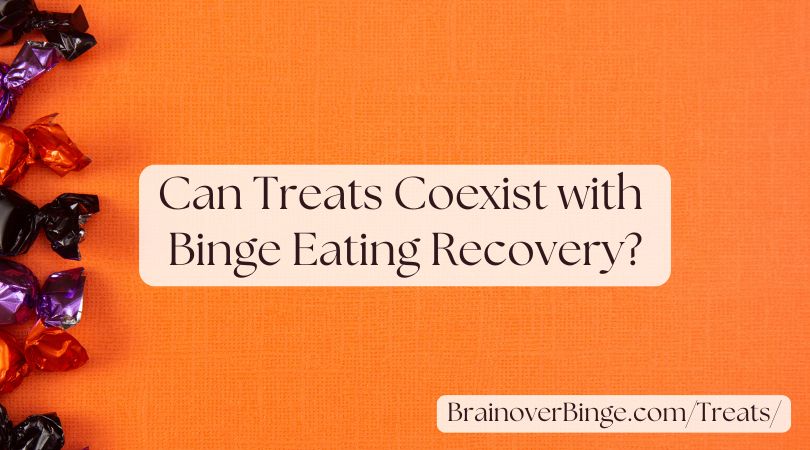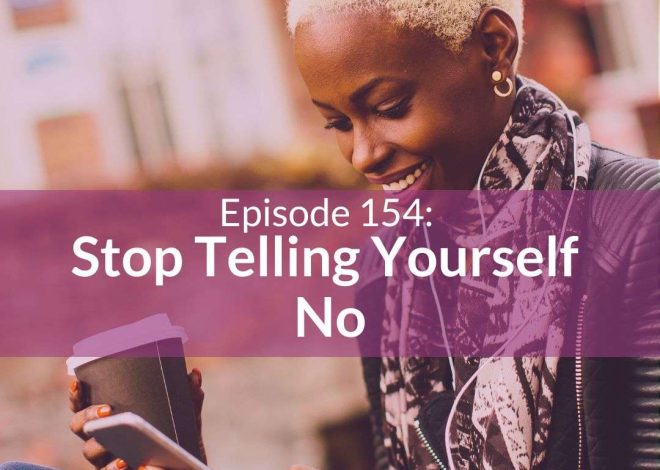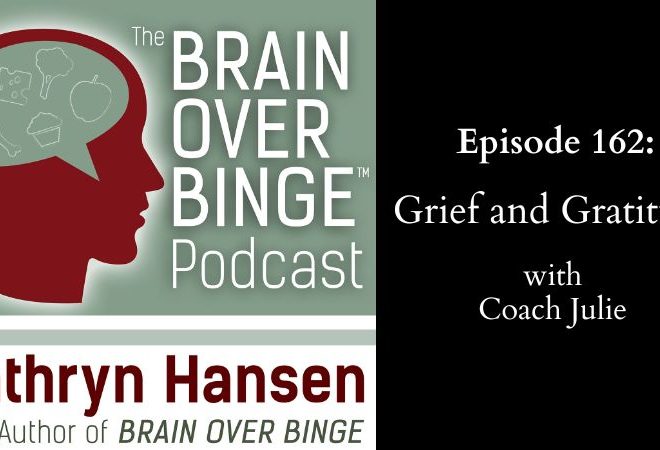
Can Treats Coexist with Binge Eating Recovery?
I wrote this blog post back in 2012, and I wanted to update it after an experience I had a few days ago while preparing for Halloween…
2012 post:
I eat Halloween candy. I also eat many other types of sweets and desserts in moderation. I don’t think continued recovery requires this, although it is extremely helpful to learn you aren’t powerless around any food. You may find that avoiding certain foods temporarily or even altogether works for you (and if you have a health condition, then elimination of specific foods may be a necessity). Even people without eating disorders sometimes choose to avoid a food because of the effect it has on them, or because it feels too difficult to stop eating it once they start. It’s up to you to decide the amount and frequency of treats and sweets in your life, and holidays can be an opportunity to determine how binge eating recovery and treats can coexist.
Halloween definitely got the best of me when I was bulimic. During my last year of college, I was struggling with frequent binges as Halloween approached, and I remember hesitantly buying a large bag of peanut butter cups for trick-or-treaters. I lived alone in a small duplex at the time, and I knew it was a possibility for me to get some kids knocking on my door on Halloween night. I didn’t have any other plans for Halloween, because at the time, my binge eating was causing so much shame and weight gain that I didn’t have much of a desire to be social.
When I bought the peanut butter cups, I knew it was a risk that I’d eat them all before Halloween. Sweets were dangerous to me. I was trying to recover at the time, and I went back and forth between trying to avoid sweets altogether and trying to learn to eat them in moderation—but neither strategy seemed to help. Sure enough, the day before Halloween, temptation took over and I ate all of the peanut butter cups during a binge. So, on Halloween night, I turned off my outside light, and didn’t answer the door.
Fast forward to today (2012), we often have candy or junk food in the house, and I don’t view it as dangerous at all, or even think much about it. Since I recovered in 2005, we’ve celebrated Halloween every year and kept candy in the house days beforehand for the trick-or-treaters. Then, after Halloween, my own kids’ trick-or-treating buckets have sat on the kitchen table—often for weeks—and I have a few pieces of candy here and there, but I don’t feel drawn to it like in the past.
I believe there are a few reasons for this change:
- I haven’t dieted or restricted calories in many years. A food-deprived body and brain make food the top priority. When you aren’t eating enough, cravings increase, and the reward value of food skyrockets. Pleasurable food is much more tempting and gives you more of a “hit”. This is a survival response designed to encourage you to eat more, and this response can continue for a while after dieting stops—until the body/brain fully senses safety from deprivation. Then, it gradually turns the volume down on cravings, even in the presence of highly pleasurable food.
- I learned to stop acting on urges to binge and problematic cravings, and therefore deconditioned the habit of overeating treats. I didn’t understand my cravings in college while bulimic. I thought my urges represented my true physical or emotional needs. When I recovered, I learned that urges to binge were a glitch in the primitive part of my brain, and I did not have to act on them. Once I ate candy or other treats in moderation many times, and experienced the urges to binge that followed—without acting on them—my brain changed and those urges went away.
- I didn’t make the treats “forbidden” or think I was a failure for eating them. When I would eat candy as a bulimic, I would often tell myself it was the “last time” I would eat that particular food, and therefore I needed to eat all I could now and then “start over tomorrow” with a clean slate of eating perfection. I didn’t realize that thinking I would “never have the candy again” made me eat so much more of it than if I just believed what I believe now—that I can have more later, or tomorrow, or another day, if I want.
It’s not that I never experience a desire for more pleasurable food, but that desire has become so much more mild after recovery, and that desire is never for massive quantities or binges—which now seems like the opposite of pleasure. Sometimes eating a sweet like Halloween candy creates a craving for a few more bites, but that is just a natural part of being human with the pleasure-seeking brain that we have, and especially in the food environment that we live in. When faced with an inclination for a little more candy, I have a choice—to have a little extra or not—but no matter what choice I make, it never has to lead to harmful behaviors like bingeing or restricting.
Recovery doesn’t mean giving up on the pleasure and enjoyment of food, it means redefining your relationship with it.
2024 update:
Just a few days ago, nearly 20 years after my recovery from binge eating and about 12 years since I wrote the blog post above, my youngest son and I went shopping together. Halloween was approaching, so we bought a bag of peanut butter cups for trick-or-treaters. Just like in college, I likely chose that particular candy for the trick-or-treaters because peanut butter cups have always been my favorite Halloween candy. Unlike in college, I know I can eat some now without it being an issue at all, so buying them didn’t create any anxiety.
My son (well, actually, both of us:-)) decided to open the bag in the car on the way home to have one. We each unwrapped a peanut butter cup and took a bite, but to my surprise, my reaction was, “it’s not even that good.” It wasn’t awful, it just wasn’t anything special. I finished the one peanut butter cup, and I didn’t have any desire for another one, which I found odd because I usually want at least one more. As I type this, the bowl of leftover peanut butter cups is sitting on my kitchen table in front of me. It’s not due to a strong will that I’m not having any, it’s a genuine lack of desire. I’ve definitely had other pleasurable foods over the past few days, but not the peanut butter cups.
I’m sharing this blog post update to tell you the following insights that I hope will help with your own recovery and relationship to treats:
- Your relationship to even your most challenging foods can change dramatically over time. You may think a food will always have power over you but stay open to the idea that this likely will not be the case. You can learn to incorporate these foods in a way that makes sense to you, and also take comfort in the fact that time naturally changes some of your preferences.
- When you allow foods and allow yourself to truly listen to your taste and your body, you may discover some formerly tempting foods aren’t even that good. I’m sure if I would have eaten that same peanut butter cup a few days ago with the “forbidden food” mentality or the idea that I would “never have a peanut butter cup again,” I would have craved and wanted much more. An allowing mindset surrounding treats lets you tune into how you feel about them—before you eat them, while you are eating them, and after you’re done.
- When you set aside the dieting mentality and approach sweets with a body that is well nourished, you gain the freedom to make genuine choices, instead of being driven by the survival instincts. When you are deprived of calories, you will feel such a strong pull from the primitive brain to eat excessive amounts, and you will have heightened cravings, which makes reasonable decisions around treats nearly impossible.
Related to these points, I read a social media post last week from Dr. Mark Hyman, in which he talked about how the ingredients in Halloween candy have changed over time to include more artificial additives and preservatives. It’s definitely possible that these chemical changes truly have made the peanut butter cups taste worse over time, which lead to my “it’s not even that good” reaction a few days ago. But, even if that is the case now, when I was a binge eater, I would have eaten the candy so quickly, mindlessly, and with so much guilt that I wouldn’t have even given myself the chance to notice if I was actually enjoying it or not.
Everyone’s experience and reaction to foods is different, and your journey will not be exactly like mine, but I’ve talked to enough recovered individuals over the years to know that my story surrounding treats is not unique. So many people have transformed their relationships with sweets and have had the experience of their most-craved desserts simply losing their allure. I hope this will give you some encouragement as we approach the holiday season so that you can find a balance that works as far as treats coexisting with your recovery.
Brain over Binge resources for more help:
Free Inspiration Booklet – The booklet contains 31 daily messages to help you stay focused and motivated each day as you let go of binge eating.
One-on-one Coaching – Book a 45-minute private and highly personalized session with Kathryn or Coach Julie. You will learn to change your thinking, uncover what is holding you back, and get on a path to complete freedom from food issues.
Group Coaching – Get help from coach Julie and support from others who are overcoming this habit. Includes a forum that is open 24/7, group coaching calls, mindfulness resources, plus course access.
Brain over Binge Course – Self-paced online lessons (plus an app) for only $18.99/month. Includes over 125 tracks to listen to that give you the information and answers you need as you end binge eating.
Brain over Binge Books – Get Brain over Binge and the Brain over Binge Recovery Guide on Amazon and Audible.


